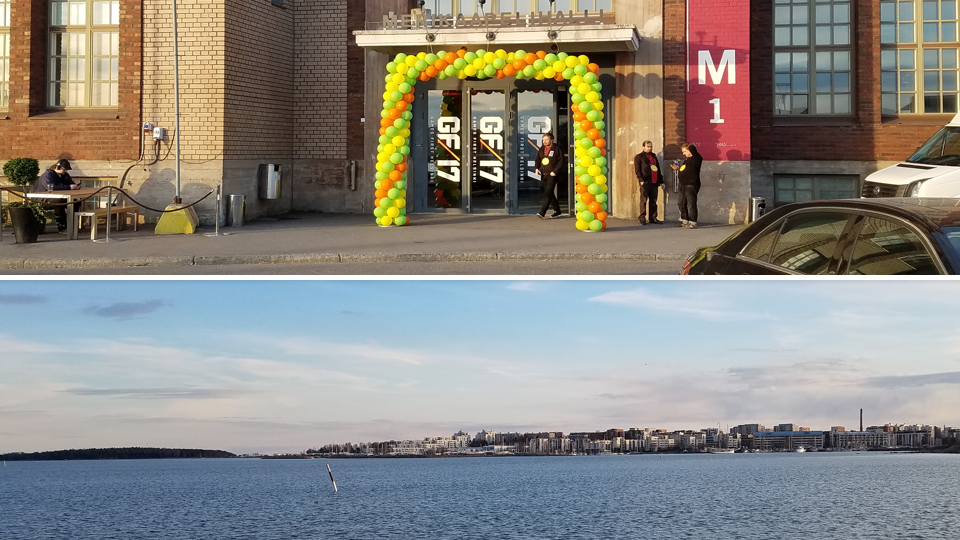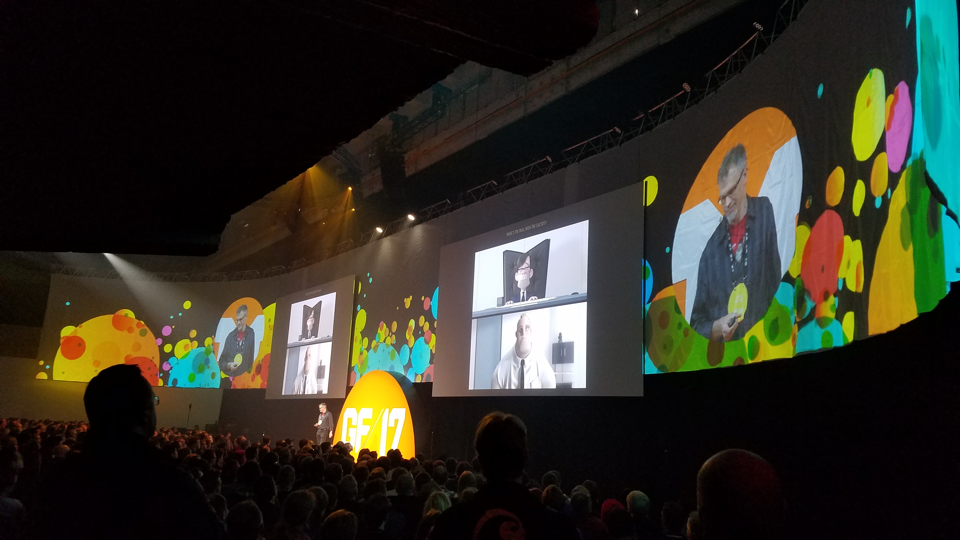Games First Helsinki 2017 take-aways
I was fortunate enough to snag a spot at Games First Helsinki 2017, so here are my take-aways.
After a slightly confusing application approval fiasco in late April, Games First took place today (9 May) in an old Nokia cable factory on a quiet corner of the Ruoholahti neighborhood overlooking the ocean. It was a full days worth of festivities, so after the weekly Unity Finland Futsal game and post-match sauna I headed straight over to the Cable Factory filled with hype. And in case you were wondering, my team suffered a horrific defeat (12-8).

The venue
On the outside the venue was pretty unassuming until you rounded the corner overlooking the water; where you were greeted by some festive balloons and a dollop of branding on the doors. I had never been to this part of Ruoholahti, and I've gotta say it's definitely a great spot to host an event as the view is stunning. Once in I was greeted by some friendly staff that gave me my badge, took my coat then directed me to where the first talk was taking place.
To get from the coat check to the main area you had to go over a tall platform overlooking the event, which was complete with a giant ball pit in the center, arcade and pinball machines on one side, a bar and pool/air hockey tables alongside tons of seating and standing areas. It was a pretty sweet setup, with the only widespread complaint being that the beer fridge didn't open up early enough.

The talks
There were a total of 6 talks, 3 of which were business focused with the other 3 focusing in some way on game design. I personally was not a huge fan of the business focused talks, but two of the game design talks were slam dunks and had me hooked from start to finish. Those two talks were Art Direction in Creative Development by Mark Holmes of Dynamighty and Crowdsourcing your game content: How to build your next title with your players by Henrique Olifiers of Bossa Studios.
Favourite talks
Art Direction in Creative Development was essentially a creative post-mortem on the game COUNTERSPY and how Mark used his prior experience at Pixar to transform the design of the game. It was an incredibly interesting dive into creative process and the evolution of the unified design language used throughout COUNTERSPY, its metagame, and all of their marketing materials. Mark had numerous examples of the artwork in various stages of development, and seeing the evolution of the artwork was fascinating.
Crowdsourcing your game content: How to build your next title with your players main focus was how Bossa utilized Maker culture on Worlds Adrift to not only allow the community to be a part of the development process, but to allow the game to be much more content rich with a much smaller team. He went through a brief introduction to Maker culture, and a few points for successfully tapping into Maker culture to crowdsource miscellaneous game features. Some of his points included:
- Giving the community access to the same toolset that you/your team will be using is crucial in getting the most out of the communities creativity. Accessible tools will make user contribution easy and enjoyable, allowing you to get the most out of their collective creativity.
- Create a positive community by removing negativity as soon as possible, and rewarding community members by not only acknowledging when they do things right but raising talented members on a pedestal. This can help spur creativity throughout the community and raise quality as the rest of the community works for that same recognition.
Transparent communication is very important ensuring your community trusts you. Remain candid, communicate well, and be as straight forward as possible without being rude. If someone suggests a bad idea on your forum, acknowledge it, state if you will implement it or not, then move on. Don't leave things open otherwise people may expect too much.
For anyone creating a game that is thinking of ways to try and create a better and more positive community or boost their games marketing through community this talk in conjunction with Rami Ismail's recent talk on how Vlambeer livestreamed development of Nuclear Throne at Aalto University a few weeks back (available to watch here) are both dynamite sources of information.
Other talks
The other four talks of the day didn't capture me as much as the two mentioned above, however they were still quite interesting. I won't go into as much detail with these ones, but here's a high-level breakdown of each one.
Maintaining Success Through Development Optimization: World of Tanks case study by Matias Myllyrinne of Wargaming was pretty much exactly what the title states; a case study on how they optimized their development of World of Tanks (and their other IPs). A surprise for me was hearing that Wargaming is as huge of a company as it is; so hearing how they set up a lead development HQ to oversee and provide consulting to the rest of the org was fascinating. The sentence that stuck out the most for me was "if managing a single region company is like an FPS, managing a global company is more like an RTS. It's not exponentially harder, it just requires a different strategy and mindset" (may have gotten the words mixed up some, but that's the gist of it).
Quest for the healthy metagame: Balancing cards in 'Clash Royale' by Stefan Engblom of Supercell was a deep dive into the planning and thought process behind how they go about balancing, re-balancing, and adding new cards to Clash Royale. It was a bit long of a talk on the subject matter and there's not much more to elaborate on, but some of their key points were:
- Make everything feel OP at the right moment, but also make sure that everything has a counter.
- When adding new things make sure to not make old features irrelevant.
- When looking to rebalance, for them it's an even split between listening to players, validating potential nerfs/buffs through data, and following your intuition.
The Reality of Failure by Michael Martinez of the former Juicebox Games was essentially a post mortem of Juicebox and his thoughts on it. I personally didn't take much from this talk and was not a huge fan of it nor the message that it sent, but luckily there's also a blog post that Michael wrote that is essentially the same as the talk, which you can check out on Medium. That said, for those looking to find out about the realities of the indie gaming world I would instead recommend checking out Rami Ismail's Reality check/de-motivational Speech on Indie Gaming, which is more relavant to most people not planning on heading out to Silicon Valley to get money from VC's.
How we made mobile MOBA popular in China by Winter Zhao of Tencent was an overview of the companies marketing strategy for King of Glory, a mobile MOBA and spin-off of League of Legends. It was quite interesting seeing the different social integrations Tencent made for not only funneling users into the game but also to increase retention, and definitely a reminder that social networks are a great marketing tool if used correctly.
Wrap-up
All-in-all Games First was a great event, and one that I will for sure be trying to make it to every year. From start to finish the event was extremely well produced, bang on schedule, excellently serviced, and excellently catered. Even though I wasn't super intrigued by some of the talks, on the whole the talks were very well chosen and no matter what you do in gaming there was something intesting to hear about. I'm very glad I was fortunate enough to get a spot this year and will be keeping my fingers crossed for next year!